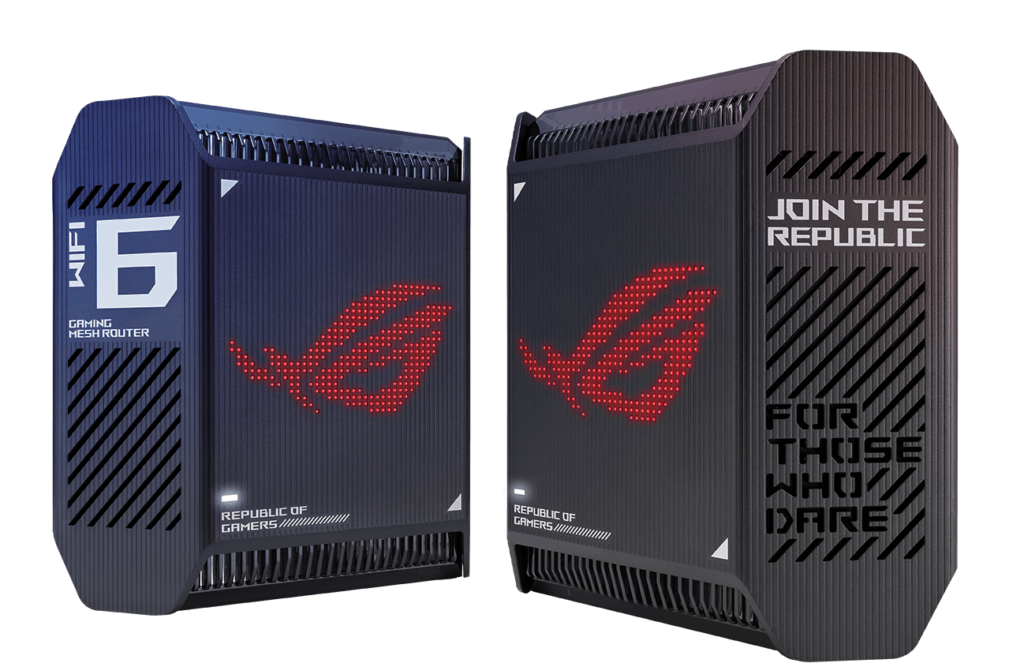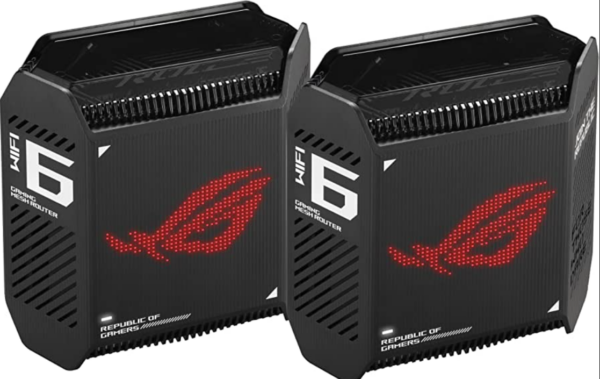In an age of Orbis, Decos, Eeros, and Nests, where monolithic white plastic reigns supreme, the $600 Asus Rog Rapture GT6 stands out among mesh routers. See it. Asus made its first mesh gaming router. The mesh router appears more like a pair of stout-statured, custom-built gaming PCs, with angular, uneven construction and dot-matrix LED logos in any color you like.
“For those who dare,” reads the relief text on each unit.
I dared because I was intrigued to see if it worked. After running the same speed tests as the Orbi, Deco, Eero, and Nest systems, I observed something unusual. The GT6 outclassed them all.
How better? Our five-room product-testing lab has gigabit download speeds up to 940 megabits per second. The GT6 averaged 809Mbps over all distances after two days of speed tests in each room. Next best is the tri-band, Wi-Fi 6 mesh router TP-Link Deco X4300 Pro, which averaged 646Mbps.
Its capability for full-width, 160MHz channels may explain its performance advantage over competitors. That upgrade lets Wi-Fi 6 routers like this one transfer large volumes of data more efficiently. The GT6 exploits recently available UNII-4 spectrum at 5.9GHz to squeeze in a third 160MHz-wide channel from Asus. That helps the system maintain rapid speeds in huge, high-traffic environments, which I saw when I tested it.
With the Asus Router app’s gamer-friendly features and a multigig WAN connector that can take cable rates up to 2.5Gbps, this is one of the best Wi-Fi 6 mesh routers on the market. Even if you’re not a gamer and detest the spacey design (some do), this is a top-of-the-line mesh router for 5,800-square-foot homes that’s worth the $600.

A wooden table holds one Asus Rog Rapture GT6 mesh gaming router. It has inbuilt antennas and a color-changing LED dot matrix logo.
Daring design
The Asus Rog Rapture GTX is a colorful mesh router for gamers. It’s not the first router to blend gaming and mesh design elements, but it’s still a stunning departure that’ll stick out in the router aisle and fit in with even the fanciest gaming setups.
A detailed look at the rear of an Asus Rog Rapture GT6 mesh gaming router shows a physical power switch, a 2.5Gbps WAN port, three spare gigabit Ethernet LAN ports, a USB 3.2 port, and the A/C power port.
Not everyone wants a Star Wars-themed router, especially a mesh router that takes up two locations in your home. Routers work best when they’re visible, so don’t hide them if it doesn’t match your decor. Instead, choose the Eero 6 Plus or TP-Link Deco X4300 Pro for a more discreet Wi-Fi 6 mesh router.
GT6 hardware is tri-band AX10000. “AX” indicates that the system supports 802.11ax, or Wi-Fi 6, while “10000” refers to the combined highest theoretical speeds of the 2.4GHz band (574Mbps) and the two 5GHz bands (4,804Mbps each). The 1.7GHz tri-core processor, 512MB of RAM, and 256MB of Flash memory are within, along with nine antennas.

Turn the GT6 over to find a WAN port that supports incoming cable rates up to 2.5Gbps, three spare gigabit Ethernet LAN ports, a physical power switch, the A/C power jack, and a rare USB 3.2 port on a mesh router. Each GT6 unit is similar, so it may connect to your modem and be your main device.
Asus Rog Rapture GT6 mesh gaming router in-app setup screenshots.
The Android or iOS Asus Router app will set up the setup. It’s a good router app, giving more capabilities and controls than most mesh competitors while remaining simple. I like that the interface doesn’t show splash adverts for premium security services like Netgear’s Nighthawk and Orbi apps.
Setup takes minutes. Select the GT6 from Asus’s router list, scan the QR code on the bottom of the device you’re connecting to your modem, choose a network name and password, and you’re done. The homescreen displays real-time upload and download traffic, CPU/RAM percentages, and connected devices. Tap the home screen to change the LED lights’ color and design. My one complaint: I couldn’t turn off the extender’s LEDs without turning off the router. Both were on or off.
The home screen also has shortcuts to two of the app’s main gaming features: a quality of service engine (QoS) that prioritizes gaming or streaming over file transfers and other bandwidth hogs, and a mobile boost mode that prioritizes gaming traffic to your phone or tablet with a button. Advanced users might find networking methods like Open NAT port forwarding controls in the many settings.

The Asus Router app also features parental controls, automatic threat checks, and VPN access. A separate Instant Guard program can tunnel your online traffic back via your home network like a VPN while traveling or utilizing public Wi-Fi networks. All of that is free. It’s great because it’s all free.
Speed and performance
The chart above illustrates the average download and upload speeds of each mesh system I’ve tested in our lab’s 1,300 sq. ft. test facility, which has a gigabit fiber connection. Our new speed champion is the Asus Rog Rapture GT6, which averages 809Mbps wireless download and 785Mbps wireless upload to our Wi-Fi 6 test laptop. Both stats are faster than any competition I’ve tested.
The GT6 achieved wireless download speeds of 850-900Mbps in all five rooms I tested, which is fantastic. However, half of the tests in the first three rooms drop to 500-to-650Mbps.
I split my speed tests into two sets: one where I start my laptop’s connection in the same room as the router (the lab’s “living room”) and work away from it, and another where I start my connection in the farthest room from the router (the “garage”) and work back toward it.
Since I started far from the router, the system routed my traffic through the extender. As I walked closer to the router, the system maintained routing my traffic through the extender, even after I returned inside the router’s room. The extender was merely adding an unneeded leap to my connection, yet the system kept using it.
My mesh routers often have “sticky client” issues, where the system persists using the extender after it should. In severe cases, such as with the last-place Linksys Velop MX2000, an issue like this could cause a significant drop in average speeds when traffic routes through an extender.
The GT6’s technology is strong enough that the speed differential isn’t obvious enough to keep it from the top speed place. It typically affects phones, laptops, and other portable devices, not stationary ones like smart home appliances or media streamers.
We track latency by pinging the same AT&T server in St. Louis for all speed tests. The GT6’s average latency was 32ms, with spikes no more than 56ms, in our most recent mesh tests. I’m reluctant to compare it to systems we tested months before because that server is beyond of our control.
Another high-end Wi-Fi 6 mesh router, the Netgear Orbi 860 Series, was tested days earlier. That system has a 19ms average latency but 64ms spikes.
If we batch test gaming routers, I’ll include the GT6 to examine how the system’s QoS restrictions and port forwarding rules affect latency.
The ruling
A $600 mesh router? I’d understand if it’s the Asus Rog Rapture GT6. It combines the best of mesh and gaming routers with fast speed for gigabit networks, easy setup, pleasant, free features, and an endearingly in-your-face style. It’s an Editors’ Choice selection and worth $600, but try to get it on sale next time.

